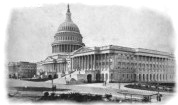Irish Neighborhoods in Old Washington

The main areas where Irish immigrants to Washington settled were as follows:
Georgetown:
Although the main wave of Irish immigration to America was during the Potato Famine, there had nonetheless been a steady influx of Irish immigrants since colonial days. Every new chapter in the ongoing saga of "troubles" brought more immigrants, as did the laws circumscribing land ownership, educational and economic opportunities for Catholics in Ireland in the 18th - 19th centuries. By the late 18th century, there were already a fair number of first and second generation Irish-Americans living in Georgetown, as the early parish registers of Holy Trinity Catholic Church, Georgetown (est. 1794) will attest.Some of the earliest immigrants became successful shopkeepers, craftsmen and small merchants, although the later influx were mostly ordinary laborers. Some Irish immigrants found work in the building of the C&O canal after the ground-breaking in 1828, and others in working as navies in Georgetown's port area, called "Wapping" after the Dockland area of London by the same name.
Construction work on the Canal continued through its completion in 1850, providing yet more jobs for the Potato Famine immigrants. Once the Canal was open, several Irish-Americans worked as watermen, whereas others found employment as casual day laborers in construction work in the expanding new National Capital across Rock Creek and in building houses in still-expanding Georgetown. Still more found work in the wide range of small manufacturing industries along the Georgetown waterfront.
In the earliest days, the main Irish neighborhood in Washington was the waterfront area, below Bridge Street (today's M St.), Georgetown's poorer area. Wealthier Irish-American residents living north of Bridge Street began to become more assimilated into the Georgetown mainstream, intermarrying with middle class Catholic families of English and German extraction.
In 1871, Georgetown's fortunes took a turn for the worse. The 1861-65 War had put a damper on the shipping trade to some extent, but the final straw was the abolition of Georgetown's independent charter and city government and its annexation by the District of Columbia. Prior to this time, Georgetown had been the most fashionable area of Washington in which to live, as the amenities int he Federal City were basic. After annexation, local money and resources were diverted toward the continuing building and development of the Federal City, major parts of which were still swampland, forest and meadow. Newer neighborhoods with fashionable new late Victorian architecture and grand, luxurious houses sprang up in Northwest Washington. Apart from a handful of older families with strong ties to the old port town, the wealthy began to leave Georgetown. By the late 19th century, Georgetown became in large part a working-class neighborhood, with areas north of Bridge Street (renamed M St. in 1895) economically accessible to the Irish, particularly the areas east of the High Street (Wisconsin Avenue) Around the turn of the century, 29th and 30th Streets were the heart of the Georgetown Irish neighborhoods.
Foggy Bottom:
In the earliest days, Rock Creek was still navigable and there were docks on either side of Rock Creek, both in Georgetown and in Foggy Bottom. The Irish neighborhood south of Bridge Street in Georgetown expanded across Rock Creek to the Foggy Bottom area, where there was more affordable housing. This area particularly grew as an Irish neighborhood in the years after the Potato Famine, up until the earliest decades of this century. Major employers in the area included the Washington Gas Light Company Gasworks and the Christian Heurich Brewery, located where the Kennedy Center stands today.Swampoodle:
The curiously-named neighborhood of Swampoodle was located in a marshy area of Capitol Hill around North Capitol Street. Gonzaga High School, the pre-eminent Catholic High School in DC, is in the heart of the old neighborhood, the sole surviving relic of the once large Irish community there, although the arrival of the Dubliner and the Irish Times in the last 20 years, has brought a modern-day Irish cultural presence to the area.Swampoodle was truly a shanty town, with ramshackle single-family housing and tenements, housing some of the poorest laborers of Washington. It was a rough area, with street gangs a common phenomenon. Oddly, it was a hot-bed of Secessionist sentiment during the 1861-65 War, with the Swampoodle residents forming a rag-tag coalition with the two other predominantly "sesesh" Washington populations, the city's Episcopalians, and the local upper classes as a whole.
"My grandmother and her parents and siblings lived on I St NW between North Capitol and First in the late 1800s. Those houses on Eye St. And K Sts. were very nice architecture although they were abandoned when I attended Gonzaga in the late 1960s. Myrtle Street was the street between Eye and H Sts where black families lived. My great grandfather ran a horse shoing trade or I guess the proper name is farrier. They owned a piano and my grandmother learned to "play by ear" and played accompaniment for silent films at the Liberty Theater near North Capitol and Florida. My sister still has some bills of sale from his business." by Lawrence T. Phelps

